Titles
Brand New Vehicle Title & Registration
Ayala Motor Vehicle Services can help you with titling and registering your brand new vehicle. We are familiar with the documents and processes for brand new vehicles, which differ from used vehicle title transfers. Brand new vehicles are issued MCO’s (Manufacturer’s Certificate of Origin) instead of titles when they are delivered to the dealer by the manufacturer. The first person or private company to purchase the vehicle will be the first title holder for the vehicle. The MCO is surrendered to MVD when you title a brand new vehicle for the first time.
A manufacturers certificate of origin (MCO) is the birth certificate document of any vehicle issued by all vehicle manufacturers (Ford, GMC, Honda, etc) and is sent to the licensed dealership for every vehicle the dealership purchases. This document is used by the dealership as the ownership document, when the vehicle is sold to the consumer.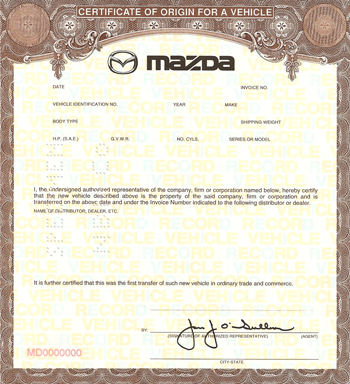
An MCO will have the following information:
- Identity of the vehicle by Vehicle Identification Number (VIN)
- Identity of the owner
- Mileage of the vehicle
- Purchaser’s name (once the vehicle has been sold)
- Lien to be entered on the title (if applicable)
An MCO can be reassigned from one dealer to another, until all reassignment fields are completed, at which time the dealer must take title to the vehicle. Once a sale takes place to a private individual or company, title must be established in the purchaser’s name.
On the front of the MCO, you should find the following information:
- The VIN for the vehicle
- The Year, Make, and Model of the vehicle
- The dealership’s name
The back of the MCO will show:
- Purchaser’s name and address (the names written here must take title to the vehicle)
The odometer reading disclosure for retail sale:
- Must be completed, or a separate secure odometer disclosure must be submitted
- The seller must write the mileage in the Odometer Reading field, and must sign and print their name in the Seller Name field
- The purchaser must also sign and print their name stating that they are aware of the odometer certification made by the seller. Only one owner’s signature is needed. Norarization is required, if not signed by a licensed Arizona dealership.
In the assignment field:
- The dealership will write their name and dealer license number
- A dealer employee will sign the MCO with their title (i.e. title clerk), Notarization is not required.
- Purchaser’s name (once the vehicle has been sold)
- Lien to be entered on the title (if applicable)
- The lienholder’s name, address, and lien date (month, day, year) is required
Arizona Vehicle Title Transfers
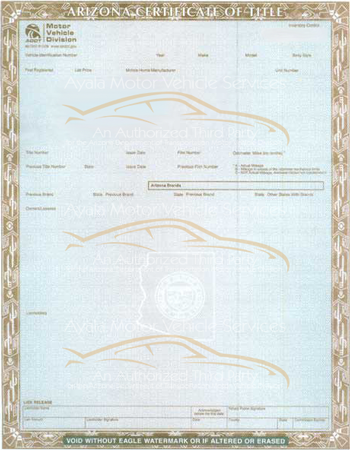
An Arizona Certificate of Title for a vehicle, when properly assigned and endorsed, is your proof of ownership document.
If either the buyer or seller have any questions regarding how to complete the title transfer, we recommend that you come into our office together, so we can get it done right the first time. It’s a sure fire way to make sure it’s done accurately, and both parties will have peace of mind.
With an authorized third party provider, the change of ownership is completed within Arizona’s MVD systems instantaneously. The buyer walks out with their title, license plate, and registration. The seller can file a sold notice, check their plate credit amount, or request a refund of the plate credit in our office for a nominal fee.
To process a title transfer from one owner to another, the buyer must present ID, must have the previous owner’s title correctly endorsed and/or notarized on the back, and if a lien was recorded on the title, a lien clearance or release will be needed. The lien release is sometimes completed and notarized on the front of the title, and sometimes is provided to the seller as a separate document.
We recommend that the seller complete and sign an Arizona Bill of Sale, and have it notarized. This can help prevent issues when the buyer comes in to complete the title transfer process, and provides the information needed for the seller to file a vehicle sold notice with MVD. The buyer should be given the original, and a copy should be kept by the seller.
The seller may also choose to complete a Power of Attorney form, and have it notarized. The Arizona Power of Attorney form grants the person named on the form, the legal authority “to sign all papers and documents required to secure the title, and further grant the authority to endorse and transfer title thereto, for the vehicle described”. This form can only be used for the vehicle shown on the Power of Attorney form, and only for the purposes quoted above.
Any of these documents can be notarized by a Notary Public, in person at any MVD office, or authorized third party provider. Notarization is required on the title for the seller’s signature, to prevent a fraudulent signature from being submitted on title transfer paperwork. Note: the seller must sign the title while in the presence of a Notary Public, or MVD agent.
The seller should make sure that the following information is completed on the title, before giving it to the buyer:
- Odometer Reading
- Seller’s Name (printed)
- Dealer Number (only if applicable)
- Seller’s Signature (must be notarized)
- Seller’s Street Address, City, State, and Zipcode
The buyer should complete the following information on the back of the title:
- Sale Date
- Buyer’s Name (printed)
- Buyer’s Street Address, City, State, and Zipcode
- New Lienholder Driver License or EIN (only if applicable)
- New Lienholder Address, City, State, Zipcode (only if applicable)
- New Lien Effective Date (only if applicable)
- Below the notary’s signature, the buyer is required to print and sign their name to indicate that they are aware of the odometer certification (vehicle mileage) stated by the seller.
The seller should always remove their plate from the vehicle, and either A) keep their plate and credit to reuse on another vehicle, B) return it and request a plate credit refund, or C) destroy it and notify MVD.
Duplicate Arizona Title
Ayala Motor Vehicle Services can help you when you’ve lost your title. A duplicate title can be printed for the owner of record, or another party who has Power of Attorney for the vehicle on the title.
Arizona’s Motor Vehicle Division charges a nominal fee for a duplicate certificate of title, and a small convenience fee is added by the authorized third party provider.
Whether you’ve lost the title, improperly completed the reassignment on the back, or the title has become damaged or mutilated, we can help.
In order to print a duplicate title, the owner shown on the title will be required to show photo ID. If another party has a Power of Attorney for the vehicle on the title, they can also obtain a duplicate title, and will also be required to show photo ID to complete the process.
Duplicate titles take just minutes to process. Skip the wait, and get in and out, with Ayala Motor Vehicle Services.
Out of State Vehicle Title Transfers
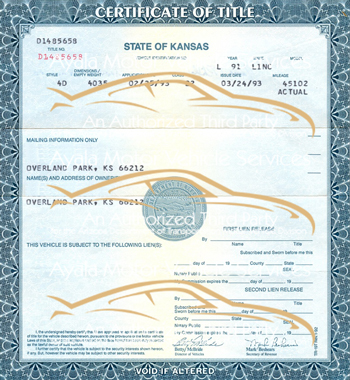
A vehicle title from another state is that vehicle’s proof of ownership document. Titles vary greatly from state to state, and their requirements to transfer ownership to a new owner do too! In most circumstances, the out of state title must be surrendered when transferring ownership and titling the vehicle in Arizona.
An Arizona resident who purchases a vehicle titled in another state must obtain an Arizona title prior to selling or transferring ownership of the vehicle to another person, company, or dealer.
When moving to Arizona, residents are required to title and register their vehicles within 30 days. If you are moving to Arizona, or have recently become an Arizona resident, you will need to surrender your out of state title, and take title in Arizona for your vehicle. You will not be required to sign the back of the title, because ownership is not changing. You will be required to show photo identification in these cases.
Note that Arizona law requires residents to update their address with the MVD within 10 days of moving. This applies to out of state license holders as well. A new resident who moves to Arizona has 30 days to obtain an Arizona driver license, and surrender their old out of state driver license.
To process an out of state title transfer from one owner to a new Arizona resident owner, the buyer must present photo identification at the time of the transaction, must have the previous owner’s title properly endorsed and/or notarized on the back, and if a lien was recorded on the title, a lien clearance or release will be needed. The lien release is sometimes completed and notarized on the title itself, and other times it is provided to the seller as a separate document.
To transfer ownership, typically the seller and buyer must both complete fields on the back of the title, including the odometer section. The seller’s signature may need to be notarized before the buyer can take title to the vehicle, but not all states require this. Look at the back of the title to determine if notarization is required.
It’s also a great idea for the seller to prepare and sign a Bill of Sale, and have it notarized. Even though it’s is an out of state title, the Arizona bill of sale form will help prevent potential issues when the buyer comes in to complete the title transfer process. The seller may also choose to complete a Power of Attorney form, and have it notarized, to allow the buyer to sign on their behalf for title transfer related documents.
All of the required documents can be notarized by any Notary Public, or in person at any MVD office or authorized third party provider, by an MVD agent. The notarization is typically only required for the seller’s signature, and is required to prevent fraudulent signatures from being submitted on title transfer paperwork.
On the back of the title, the seller will need to complete and sign certain fields, which vary from state to state. Generally speaking, the following information is found on most titles…
- Odometer Reading
- Seller’s Name (printed)
- Seller’s Signature (may need to be notarized)
- Seller’s Street Address, City, State, and Zip Code
- Note, if notarization is required, the Seller MUST SIGN in the presence of a Notary Public, or an MVD agent!
The buyer should review the back of the out of state title, to ensure that no fields were missed by the seller. The buyer will also need to complete and sign certain fields, which vary from state to state. Generally speaking, the following information is found on most titles…
- Buyer’s Name (printed)
- Buyer’s Signature
- Sale Date
- Buyer’s Street Address, City, State, and Zip Code
- Odometer Reading
Note that there may be other fields that appear, and may be required, to transfer ownership for an out of state title. We highly recommend that you thoroughly review the front and back of the title to ensure that the seller has properly completed all required fields. If you have any questions or doubts, please bring the title in question to our office for review. We can let you know which items must be completed. It is a really good idea to complete a Bill of Sale and a Power of Attorney any time you are buying a vehicle with an out of state title, or where the seller resides out of state. It can be much more difficult, and sometimes impossible, to contact the seller to obtain signatures after the sale.
Arizona Mobile Home Title Transfers

An Arizona mobile home certificate of title, when properly assigned and endorsed, is your proof of ownership document.
To process a title transfer from one owner to a new owner, the buyer must present photo identification at the time of the transaction, must have the previous owner’s title properly endorsed and/or notarized on the back, and if a lien was recorded on the title, a lien clearance or release will be needed. The lien release is sometimes completed and notarized on the front of the title, and sometimes is provided to the seller as a separate document.
To transfer ownership, the seller and buyer must both complete fields on the back of the title. The seller’s signature must be notarized before the buyer can take title to the mobile home, except in very specific circumstances.
It’s also a great idea for the seller to prepare and sign a Bill of Sale, and have it notarized. This will help prevent potential issues when the buyer comes in to complete the title transfer process. The seller may also choose to complete a Power of Attorney form, and have it notarized, to allow the buyer to sign on their behalf for title transfer related documents.
All of the required documents can be notarized by any Arizona Notary Public, or in person at any MVD office or authorized third party provider, by an MVD agent. The notarization is typically only required for the seller’s signature, and is required to prevent fraudulent signatures from being submitted on title transfer paperwork.
The seller should make sure that the following information is completed, and signed:
- Seller’s Name (printed)
- Dealer Number (only if applicable)
- Seller’s Signature (must be notarized)
- Seller’s Street Address, City, State, and Zip code
- Note, the Seller MUST SIGN in the presence of an Arizona Notary Public, or an MVD agent!
The buyer should complete the following information on the back of the title:
- Buyer’s Name (printed)
- Sale Date
- Buyer’s Street Address, City, State, and Zip code
- New Lienholder Driver License or EIN (only if applicable)
- New Lienholder Address, City, State, Zip code (only if applicable)
- New Lien Effective Date
Trailer Title Transfers
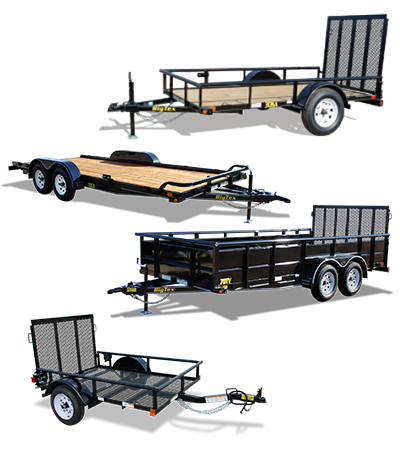
An Arizona Certificate of Title for a trailer, when properly assigned and endorsed, is your proof of ownership document.
If either the buyer or seller have any questions regarding how to complete the title transfer, we recommend that you come into our office together, so we can get it done right the first time. It’s a sure fire way to make sure it’s done accurately, and both parties will have peace of mind.
With an authorized third party provider, the change of ownership is completed within Arizona’s MVD systems instantaneously. The buyer walks out with their title, license plate, and registration. The seller can file a sold notice, check their plate credit amount, or request a refund of the plate credit in our office for a nominal fee as well.
To process a title transfer from one owner to another, the buyer must present ID, must have the previous owner’s title correctly endorsed and/or notarized on the back, and if a lien was recorded on the title, a lien clearance or release will be needed. The lien release is sometimes completed and notarized on the front of the title, and sometimes is provided to the seller as a separate document.
We recommend that the seller complete and sign an Arizona Bill of Sale, and have it notarized. This can help prevent issues when the buyer comes in to complete the title transfer process, and provides the information needed for the seller to file a sold notice with MVD. The buyer should be given the original, and a copy should be kept by the seller.
The seller may also choose to complete a Power of Attorney form, and have it notarized. The Arizona Power of Attorney form grants the person named on the form, the legal authority “to sign all papers and documents required to secure the title, and further grant the authority to endorse and transfer title thereto, for the vehicle described”. This form can only be used for the vehicle (or, in this case, trailer) shown on the Power of Attorney form, and only for the purposes quoted above.
Any of these documents can be notarized by a Notary Public, in person at any MVD office, or authorized third party provider. Notarization is required on the title for the seller’s signature, to prevent a fraudulent signature from being submitted on title transfer paperwork. Note: the seller must sign the title while in the presence of a Notary Public, or MVD agent.
The seller should make sure that the following information is completed on the title, before giving it to the buyer:
- Seller’s Name (printed)
- Dealer Number (only if applicable)
- Seller’s Signature (must be notarized)Seller’s Street Address, City, State, and Zip code
The buyer should complete the following information on the back of the title:
- Sale Date
- Buyer’s Name (printed)
- Buyer’s Street Address, City, State, and Zip code
- New Lienholder Driver License or EIN (only if applicable)
- New Lienholder Address, City, State, Zip code (only if applicable)
- New Lien Effective Date (only if applicable)
Salvage & Restored Salvage Title Brands
What does “Salvage” mean?
Sometimes cars that have been stripped, damaged in an accident, or flooded are determined to be salvageable. It depends on whether your insurance company considers it more cost effective to repair the car, or call it a total loss and send it to the wrecking yard. If it goes with the latter, the Motor Vehicle Division will brand the vehicle’s title as salvage, deeming it unfit for operation on the road. The salvage brand remains on the vehicle’s record and cannot be removed, except if the salvage vehicle is restored, crushed, or dismantled, in which case the brand may change.
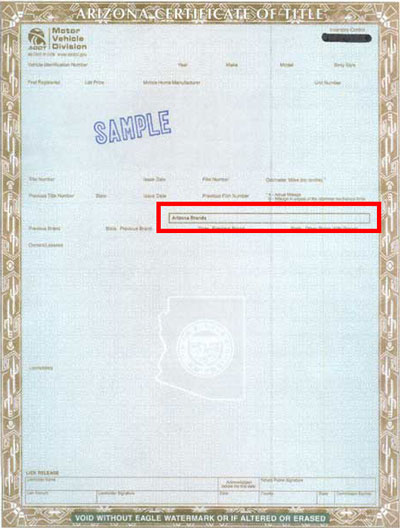
What does “Restored Salvage” mean?
You can choose to restore the salvage vehicle to make it ready for the road, but it will be the MVD that has the final say. Once you have completed the necessary repairs, your salvage vehicle must be inspected to verify that it is fit for operation on the road.
You will need to make an appointment at one of several MVD inspection facilities to do so. When you go, bring proof of ownership (likely the title), your driver license, $50 to cover the level III inspection fee, and the receipts for the work and parts you have put into restoring the vehicle.
After your car passes the inspection, it can be issued a new title, branded with the term Restored Salvage. This will alert all future owners that it was rebuilt after being severely damaged. The restored salvage brand remains on the vehicle’s record and cannot be removed, except if the vehicle is crushed, dismantled, or becomes salvage again, in which case the brand may change.
Buying a Restored Salvage Vehicle
There is risk involved in buying a restored salvage vehicle. While many of the parts may be new, there will be some that are not, and even trained mechanics cannot always gauge the life expectancy of a vehicle. Further, the vehicle will be difficult to resell if you ever choose to. Very few, if any, dealers will take it as a trade-in.
It is for these reasons that the state of Arizona mandates that sellers must disclose that a car has held a salvage title before they sell it to a buyer.
ADOT Inspection Locations (Levels II/III)
Hours for the ADOT ECD Glendale, Tempe, Scottsdale and Mesa offices have been changed to 7 a.m. to 3:30 p.m., Monday through Thursday. All inspection bays at these locations are closed on Friday. This change only affects the ADOT Enforcement and Compliance Vehicle Inspection bays for levels II and III inspections. For automated information, call 602.712.2340
Arizona Title Brands: Junk, Dismantled, Crushed & Flooded
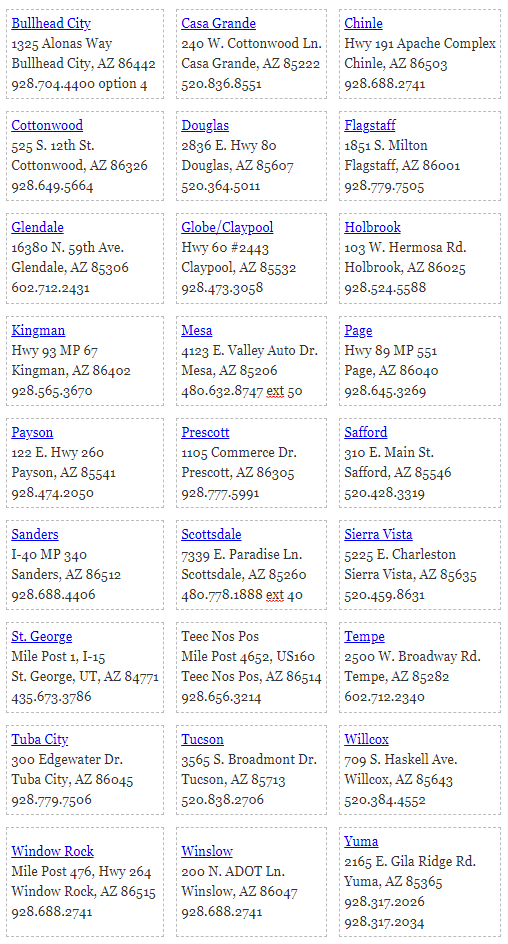 Certain title brands convey specific information about the history of the vehicle, and may dictate whether or not they may be titled, registered, or driven in the State of Arizona. In nearly all cases Junk, Crushed, and Dismantled branded titles indicate that the vehicle will never be allowed to operate on the roads again. The vehicles may be used for parts, but they should never be driven once branded in this manner.
Certain title brands convey specific information about the history of the vehicle, and may dictate whether or not they may be titled, registered, or driven in the State of Arizona. In nearly all cases Junk, Crushed, and Dismantled branded titles indicate that the vehicle will never be allowed to operate on the roads again. The vehicles may be used for parts, but they should never be driven once branded in this manner.
Crushed Title Brand
The frame or chassis of the vehicle has been crushed or otherwise destroyed so that it is physically impossible to use it in constructing a vehicle.
Dismantled Title Brand
The vehicle should only be sold as parts and cannot be legally driven; or the vehicle’s owner has irreversibly designated the vehicle as a source of parts or scrap. This vehicle should never be titled or registered.
Junk Title Brand
This vehicle is incapable of safe operation for use on U.S. roads or highways and has no resale value except as a source of parts or scrap, or the vehicle’s owner has irreversibly designated the vehicle as a source of parts or scrap. This vehicle should never be titled or registered.
Salvage Title Brand
A vehicle that can be repaired but which would cost more than some predefined amount (often 75-100% of the car’s value) to repair. Subject to structural safety inspection before it can be driven; documentation of repairs and sources of repair parts may also be required, depending on jurisdiction. Alternately, some jurisdictions (i.e. NJ) issue a standard title with a “salvage” suffix to indicate a reconstructed vehicle, as opposed to a “rebuilt” or “reconstructed” title (i.e. PA).
Restored Salvage Title Brand
A vehicle that has been previously branded as salvage but has been rebuilt/repaired and re-inspected. These vehicles are drive-able but the rebuilt brand remains on the vehicle’s title/registration documents permanently. Some jurisdictions require that rebuilt vehicles imported across provincial or state lines be re-inspected before being allowed to retain the rebuilt title.
